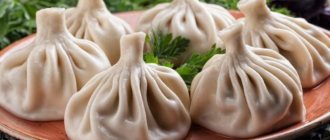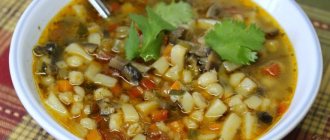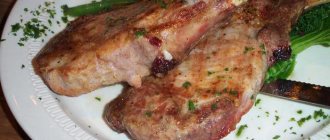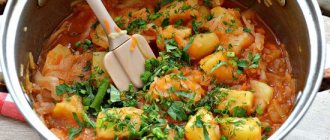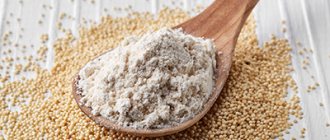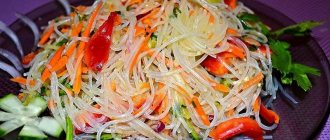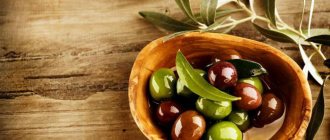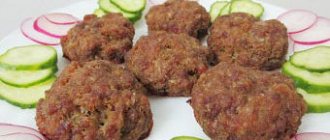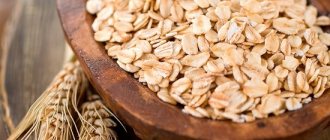Chemical composition
The chemical composition of rabbit meat can be characterized as follows: a lot of protein (20-22%), little fat (10-11%), moderate content of purine bases and cholesterol. Rabbit meat is tender because it contains little connective tissue fiber. Thanks to this, it cooks quickly and is easy to chew.
Rabbit meat proteins contain nineteen amino acids, including all essential ones (indispensable for humans).
Essential amino acids
| Name | Content per 100 g, grams |
| Arginine | 1,5 |
| Valin | 1,1 |
| Histidine | 0,6 |
| Isoleucine | 0,9 |
| Leucine | 1,8 |
| Lysine | 2,2 |
| Methionine | 0,5 |
| Threonine | 0,9 |
| Tryptophan | 0,4 |
| Phenylalanine | 0,5 |
Of the essential amino acids, 100 g of this meat contains a lot of tryptophan (50% of the daily requirement), valine, isoleucine (45% each), leucine (40%), histidine and methionine (30% each).
Rabbit meat fats are represented by both saturated and unsaturated fatty acids (FA), which is a rare phenomenon for animal fat.
Composition of fats
| Name | Content per 100 g, grams |
| Saturated fatty acids | 4,9 |
| Monounsaturated fatty acids | 4,5 |
| Omega-3 | 0,4 |
| Omega-6 | 2,7 |
| Polyunsaturated fatty acids (except omega) | 0,8 |
| Cholesterol | 0,025-0,04 |
The ratio of saturated and unsaturated fatty acids in rabbit meat is almost ideal: it is 1:2. This proportion keeps fatty acids in a liquid state, which has a good effect on lipid metabolism in the body. Rabbit fat contains a lot of lecithin, a complex of phosphatides that exhibits an anti-cholesterol effect.
There are practically no carbohydrates in this meat product, so they do not play a biological role.
Among the vitamins in rabbit meat, vitamin B12 (140% of the daily requirement), nicotinic acid (up to 60%), pyridoxine and choline (25% each) are of great importance.
Vitamins and vitamin-like compounds
| Name | Content per 100 g, milligrams |
| Provitamin A (carotene) | 0,1 |
| Vitamin B1 (thiamine) | 0,12 |
| Vitamin B2 (riboflavin) | 0,18 |
| Vitamin B4 (choline) | 116,0 |
| Vitamin B6 (pyridoxine) | 0,5 |
| Vitamin B9 (folic acid) | 0,008 |
| Vitamin B12 (cyanocobalamin) | 0,0043 |
| Vitamin PP (nicotinic acid) | 12,0 |
| Vitamin C (ascorbic acid) | 0,8 |
| Vitamin E (tocopherol) | 0,5 |
The mineral composition of rabbit meat is also very rich: it contains many macro- and microelements in quantities significant for the human body.
The most important minerals are cobalt (160% of the daily requirement), sulfur and phosphorus (23-24% each), zinc and chromium (up to 20%), potassium and copper (about 15%). Mineral content
| Name | Content per 100 g, milligrams |
| Potassium | 340,0 |
| Sulfur | 225,0 |
| Phosphorus | 190,0 |
| Chlorine | 80,0 |
| Sodium | 55,0-59,0 |
| Calcium | 20,0 |
| Magnesium | 25,0 |
| Iron | 3,3-3,5 |
| Zinc | 2,3 |
| Cobalt | 0,162 |
| Fluorine | 0,075 |
| Manganese | 0,013 |
| Copper | 0,013 |
| Chromium | 0,009 |
| Molybdenum | 0,005 |
| Iodine | 0,005 |
Rabbit meat is a low-calorie animal product: its calorie content is about 180 kcal per 100 g.
Stewed rabbit
- Cut the rabbit into portions.
- Sprinkle with salt and leave for a while to soak the meat.
- Finely chop the onion and fry in oil.
- Heat a frying pan, add oil and fry the rabbit portions on both sides for 3 minutes each.
- Place the rabbit and onion in a saucepan, add water and simmer for 40 minutes.
- Then add sour cream, stir and simmer for another 40 minutes.
Stewed Rabbit Recipe Ingredients:
- Rabbit - 500 gr.
- Onions - 30 gr.
- Sour cream - 150 gr.
- Vegetable oil - 2 tbsp.
- Water - 150 ml.
- Salt - 4 gr.
Nutritional value of the “Rabbit Stew” dish (per 100 grams):
Calories: 146.4 kcal.
| Product | Measure | Weight, g | Bel, gr | Fat, g | Angle, gr | Cal, kcal |
| rabbit | 500 gr | 500 | 105 | 40 | 0 | 780 |
| bulb onions | 30 gr | 30 | 0.42 | 0 | 3.12 | 12.3 |
| sour cream 10% (low-fat) | 150 gr | 150 | 4.5 | 15 | 4.35 | 172.5 |
| sunflower oil | 2 tbsp. | 34 | 0 | 33.97 | 0 | 305.66 |
| water | 150 ml | 150 | 0 | 0 | 0 | 0 |
| salt | 4 g | 4 | 0 | 0 | 0 | 0 |
| Total | 868 | 109.9 | 89 | 7.5 | 1270.5 | |
| 1 serving | 145 | 18.3 | 14.8 | 1.2 | 211.7 | |
| 100g | 100 | 12.7 | 10.3 | 0.9 | 146.4 |
This is a custom recipe, so there may be errors and typos. If you find them, please write them in the comments below the recipe and we will correct them.
Step-by-step recipes with photos from our website are in the “Recipes” section.
Liked? Rate it and save it on your social network page!
Beneficial features
Tasty, low-calorie and easily digestible rabbit meat has many beneficial effects on most organs and systems of the human body.
When regularly present in the diet, rabbit meat affects the cardiovascular and hematopoietic systems:
- reduces the concentration of cholesterol in the blood;
- improves vascular elasticity;
- dilates peripheral blood vessels;
- increases the tone of the venous walls;
- helps reduce blood pressure;
- reduces the permeability of vascular walls;
- restores damaged intima of arteries and veins;
- normalizes blood viscosity;
- improves myocardial oxygenation;
- helps increase hemoglobin levels.
Rabbit meat has a stimulating effect on the digestive organs:
- accelerates the restoration of cells in the mucous membranes of the digestive tract;
- promotes the secretion of pancreatic juice;
- reduces the viscosity of bile, thereby preventing congestion in the bile ducts and bladder;
- increases bile secretion;
- normalizes intestinal motility.
Rabbit meat contains much fewer allergens than other types of meat, so it can be consumed by people with multiple food allergies.
Proteins, fatty acids, vitamins and minerals of rabbit meat are beneficial:
- children;
- pregnant women;
- women who are breastfeeding;
- elderly people and old people;
- convalescent;
- during severe and long-term illnesses;
- with weakened immunity.
The low calorie content of rabbit meat allows it to be included in the diet of obese people and those on diets.
Ingredients Stewed rabbit with vegetables
| Water | 700 g |
| Onions (Frying) | 196 g |
| Carrots, red (Baked) | 107 g |
| Rabbit meat (Stew) | 1530 g |
Nutritional value and chemical composition of “Rabbit stewed with vegetables.”
The energy value of Rabbit stewed with vegetables is 125.5 kcal.
Primary Source: Created in the application by the user. Read more.
** This table shows the average levels of vitamins and minerals for an adult. If you want to know the norms taking into account your gender, age and other factors, then use the “My Healthy Diet” application.
Harmful properties
It is rare to be allergic to rabbit meat, but some people do develop it. If you have an allergic reaction to rabbit meat, its consumption is prohibited.
In terms of the content of purine bases, rabbit meat is the “anti-leader” among all types of meat: it contains the smallest amount of them - 38-40 mg of purines per 100 g. For comparison, there are 48 mg in 100 g of veal, and up to 70 mg in 100 g of pork. . Therefore, rabbit meat is the type of meat that is allowed in small quantities for patients with gout, but not more than three to four times a month.
Due to the purine content, children with hyperexcitability of the nervous system and those with a neuro-arthritic type of constitution (diathesis) should limit the amount of rabbit meat consumed.
The consumption of rabbit meat by patients with psoriatic dermatitis should be limited to two to three meals per week. At the same time, it must be cooked without fat, that is, by boiling or steaming.
Application in medicine
Considering the beneficial properties that rabbit meat exhibits on the human body, it is recommended to include it in the diet for various diseases:
- circulatory system (atherosclerosis, post-infarction and post-stroke conditions, arterial hypertension, coronary heart disease);
- digestive organs (gastritis, peptic ulcer, biliary dyskinesia, hepatitis, fatty liver, pancreatitis, colitis);
- metabolism (obesity, diabetes, protein deficiency);
- blood system (anemia, weakened immunity, pancytopenia);
- allergies.
It is useful to consume this meat product for patients suffering from dermatological diseases. Substances contained in rabbit meat accelerate the healing of wounds on the skin and improve its condition.
In order for rabbit meat to be beneficial and not show harmful properties in various diseases in humans, it must be prepared in gentle ways: boiling, steaming, stewing. Frying and baking rabbit meat increases its calorie content, increases the content of purine bases, destroys amino acids and vitamins, and oxidizes beneficial fatty acids.
Rabbit calories
Sep-15-2017 Author: KoshkaS
Rabbit meat is considered white and is one of the most dietary products, therefore it is highly valued. The dietary properties of rabbit meat lie primarily in the high content of easily digestible protein, while there is very little fat in it. As a result, almost any dish prepared from rabbit turns out to be a real delicacy and can satisfy even the most demanding taste.
It has a pleasant taste and subtle aroma. Meat is easily digested by the human body. Unlike any other meat, it contains the least cholesterol and fat, and, on the contrary, more proteins. Rabbit meat helps maintain normal fat metabolism and nutrient balance in the body, so nutritionists advise using it more often in your diet. Wild rabbit meat is darker and more flavorful than domestic rabbit meat.
The meat of old animals needs to be marinated and stewed for a long time. It makes excellent roast, jelly, stew or rabbit in white sauce.
Forelegs, neck and shoulder blade. These parts of the carcass are used to prepare stews or bases for sauces.
Back and abdomen. The back of the rabbit makes an excellent roast, while the belly is separated, cut into small pieces and used to make sauce.
Rabbit hind legs are often sold separately. They are used to prepare roasts and stews.
The dietary properties of rabbit meat are the reason why doctors recommend this meat to children, including as first complementary foods, to the elderly and the sick. You can prepare a huge number of dishes from rabbit meat: excellent main courses, broths and soups.
It has long been noted that the systematic inclusion of rabbit meat in the daily menu (of course, within reasonable limits) has a beneficial effect on metabolic processes and maintains the necessary balance of nutrients. It is no coincidence that rabbit meat is recommended for the following ailments:
- gastritis.
- ulcer of the stomach and duodenum.
- colitis and enterocolitis.
- hypertension.
- atherosclerosis.
- diabetes.
- all kinds of diseases of the liver, biliary tract, heart, gastrointestinal tract and kidneys.
- various types of allergies (except allergies to rabbit meat itself).
For long-term storage, rabbit meat is salted and smoked, and salting is usually used for subsequent smoking.
Rabbit meat has very little fat, so if cooked incorrectly it becomes dry. That's why it's best to bake or stew it, or fry it to a thin pink crust, giving it the opportunity to cook in its own juices.
How many calories are in rabbit meat?
The calorie content of a rabbit is low and amounts to:
156 kcal per 100 grams of product
Proteins, fats and carbohydrates (BJU) in rabbit per 100 grams:
How to cook the dish “Rabbit Stewed with Vegetables”
- Chop the rabbit carcass into pieces, wash and dry.
- Fry the rabbit in vegetable oil in a frying pan until golden brown.
- Add chopped onions, carrots, finely chopped garlic.
- Salt, pepper, add soy sauce.
- Add water, close the lid, let it boil and reduce the heat.
- Simmer for 1.5 hours.
- Rabbit – 700 gr.
- Carrots – 200 gr.
- Onions – 200 gr.
- Garlic – 15 gr.
- Sunflower oil – 3 tbsp.
- Water – 100 ml.
- Soy sauce – 20 ml.
- Salt – 7 gr.
- Ground black pepper – 4 gr.
Nutritional value of the dish “Rabbit stewed with vegetables” (per 100 grams):
Hello, dear friends of the project https://dieta-pohudei.ru!
Today we will look at how to prepare rabbit stewed in sour cream - the recipe for this dish is quite simple, but at the same time it can be safely served even at the holiday table. The recipe for stewed rabbit will be of interest to all connoisseurs of meat dishes for whom fatty pork, lamb, duck or turkey are contraindicated.
Outdoor use
Rabbit fat is used as a remedy for external use for various skin diseases (trophic ulcers, psoriasis, eczema, dry calluses, wounds, burns).
It is also used to enhance hair growth by mixing it with butter and honey in equal proportions and adding a clove of garlic. The freshly prepared product must be rubbed into the scalp. 60 minutes after application, rinse with warm water. After several procedures, the hair becomes stronger and begins to grow faster.
Rabbit stewed with vegetables in a slow cooker: composition, calorie content and nutritional value per 100 g
To prepare a diet rabbit in a slow cooker, we will need the following ingredients: rabbit, carrots, onions, garlic, rosemary, olive oil, salt, coriander, water.
Pour a little olive oil into the multicooker bowl and add the rabbit, cut into portions. Close the multicooker lid and turn on the “Baking” mode for 30 minutes. While the rabbit is cooking, let's prepare the vegetables.
We clean large carrots and cut them into cubes.
Peel the onion and garlic. Cut the onion into cubes, garlic into thin slices. We tear off the leaves from the rosemary sprig.
After 30 minutes from the start of cooking the rabbit, turn off the multicooker; the rabbit has become slightly fried. Mix the rabbit pieces.
Add carrots to the rabbit.
We also add onion, garlic and rosemary.
And be sure to add salt and coriander to the multicooker bowl.
Pour hot boiled water into the multicooker bowl, mix the contents of the bowl, close the multicooker lid and turn on the “Stew” mode for 1 hour.
After an hour, the rabbit stewed with vegetables in a slow cooker is ready. Serve the rabbit with any side dish as a second course.
Rabbit cooked in a slow cooker turns out tender, soft, juicy and nutritious! Great dish for lunch! Bon appetit!
How to select and store
When choosing a rabbit carcass on the market, you need to follow simple recommendations:
- you need to refuse to buy this product in spontaneous markets where there is no sanitary and veterinary laboratory and conditions for the sale of chilled meat;
- you should check for the presence of a veterinary stamp;
- carcass weight should not be less than 1100 g;
- the carcass must be completely bled;
- the surface of the meat should be moderately moist and elastic;
- There should be no foreign odors from the meat, except for the slight smell of fresh meat.
Fresh meat cannot be used for cooking: it must be ripe. To be sure of the ripeness of meat, after purchase it must rest for at least 8 hours in the refrigerator.
The shelf life of rabbit meat depends on storage conditions and is:
- in the freshness zone of the refrigerator at a temperature from 0 to +2°C - up to five days;
- in the refrigerator at a temperature from +2°C to +6°C - up to two days;
- in the freezer at a temperature of -18°C - 6 months;
- in the freezer in vacuum packaging at a temperature of -18°C - 10 months.
Stewed rabbit with vegetables
- Chop the rabbit carcass into pieces, wash and dry.
- Fry the rabbit in vegetable oil in a frying pan until golden brown.
- Add chopped onions, carrots, finely chopped garlic.
- Salt, pepper, add soy sauce.
- Add water, close the lid, let it boil and reduce the heat.
- Simmer for 1.5 hours.
Ingredients for the recipe “Rabbit Stewed with Vegetables”:
- Rabbit - 700 gr.
- Carrots - 200 gr.
- Onions - 200 gr.
- Garlic - 15 gr.
- Sunflower oil - 3 tbsp.
- Water - 100 ml.
- Soy sauce - 20 ml.
- Salt - 7 gr.
- Ground black pepper - 4 gr.
Nutritional value of the dish “Rabbit stewed with vegetables” (per 100 grams):
Calories: 136.1 kcal.
| Product | Measure | Weight, g | Bel, gr | Fat, g | Angle, gr | Cal, kcal |
| rabbit | 700 gr | 700 | 147 | 56 | 0 | 1092 |
| carrot | 200 gr | 200 | 2.6 | 0.2 | 13.8 | 64 |
| bulb onions | 200 gr | 200 | 2.8 | 0 | 20.8 | 82 |
| garlic | 15 g | 15 | 0.98 | 0.08 | 4.49 | 21.45 |
| sunflower oil | 3 tbsp. | 51 | 0 | 50.95 | 0 | 458.49 |
| water | 100 ml | 100 | 0 | 0 | 0 | 0 |
| Heinz soy sauce | 20 ml | 20 | 0.52 | 0 | 8.6 | 36.6 |
| salt | 7 g | 7 | 0 | 0 | 0 | 0 |
| ground black pepper | 4 g | 4 | 0.42 | 0.13 | 1.55 | 10.04 |
| Total | 1297 | 154.3 | 107.4 | 49.2 | 1764.6 | |
| 1 serving | 259 | 30.9 | 21.5 | 9.8 | 352.9 | |
| 100g | 100 | 11.9 | 8.3 | 3.8 | 136.1 |
This is a custom recipe, so there may be errors and typos. If you find them, please write them in the comments below the recipe and we will correct them.
Step-by-step recipes with photos from our website are in the “Recipes” section.
Liked? Rate it and save it on your social network page!
Use in cooking
Rabbit meat is a universal meat product in its preparation method. The rabbit is boiled, steamed, grilled, baked, fried, stewed, smoked.
Before heat treatment, rabbit meat is often marinated in sour cream, whey, vinegar, and white wine. The marinade prevents the meat from drying out during frying or baking. It goes well with seasonings:
- black pepper;
- oregano;
- bay leaf;
- thyme;
- celery;
- cloves;
- cinnamon;
- basil;
- parsley;
- dill;
- garlic;
- juniper.
Due to the fact that it contains a little of its own fat, rabbit meat can be prepared as both a dietary and high-calorie dish.
Diet bunny
To prepare it you need to take: half a rabbit carcass (preferably the front one), celery root, one carrot, two onions, salt and bay leaf. Small pieces of meat need to be poured with water, boiled over high heat and boiled until a large amount of foam appears. After this, drain all the liquid and wash the pan. Place the washed meat back into the pan, add boiling water, add salt and bring to a boil over low heat. Pour peeled and cut into strips vegetables into the boiling broth. Simmer over low heat for at least an hour. Before turning off, add bay leaf. You can serve with blanched broccoli or asparagus.
Non-diet rabbit in sour cream sauce
Best materials of the month
- Coronaviruses: SARS-CoV-2 (COVID-19)
- Antibiotics for the prevention and treatment of COVID-19: how effective are they?
- The most common "office" diseases
- Does vodka kill coronavirus?
- How to stay alive on our roads?
For this dish you will need: 0.5 kg of rabbit, a glass of sour cream and water, an onion, 2 tablespoons of butter, salt to taste, seasonings (turmeric, paprika, Italian herbs, white pepper). In a hot frying pan greased with butter, brown the rabbit pieces. Saute the onion, peeled and cut into rings or half rings, in butter in a separate frying pan until transparent. Mix sour cream with water, salt and spices to taste. Place the fried rabbit and onion in a saucepan, pour in the prepared sour cream filling. Simmer the dish over low heat for 1.5-2 hours (depending on the age of the rabbit).
Recipe description: Rabbit stewed with vegetables in a slow cooker:
Rabbit meat is dietary meat and very tasty! Rabbit can be cooked in several ways, but the simplest is stewing rabbit with vegetables. In addition, the dish turns out to be very dietary, since a minimum of oil is used, a maximum of vegetables is used, and water is used as the liquid in which the cooking process will take place. The rabbit comes out juicy, aromatic, and tender. In addition to this, carrots cut into cubes, thanks to stewing in a slow cooker, retain their shape and serve as an excellent addition to rabbit meat as part of a side dish. Rabbit according to this recipe can be cooked either in a slow cooker or in a saucepan on the stove. This recipe used a Polaris PMC 0517AD multicooker, device power 860 W, bowl volume 5 liters.
